
Looking for ACTIONABLE ideas to engage your employees who are (suddenly) working from home? Discover 10 great remote employee engagement methods! All of them are very easy and completely free to implement.
Looking for ACTIONABLE ideas to engage your employees who are (suddenly) working from home? Discover 10 great remote employee engagement methods! All of them are very easy and completely free to implement.
Wondering how to motivate and engage your employees who are working from home?
You’ve come to the right place. In this blog post, I’ll share with you 10 actionable ideas you can put into practice right away! They are very easy to implement and cost absolutely nothing.
So let’s dive right into it! 🤿
Here are my favorite ways to motivate and engage remote employees who are working from home:
Setting clear expectations is the first thing you need to do if you want to ensure high engagement among your employees who are working from home. Do your employees know exactly what is expected of them while they work from home?
To make that clear for all your employees, you should institute a remote work policy or so-called “remote work playbook”. This is a document that explains how your company implements remote work. 📝
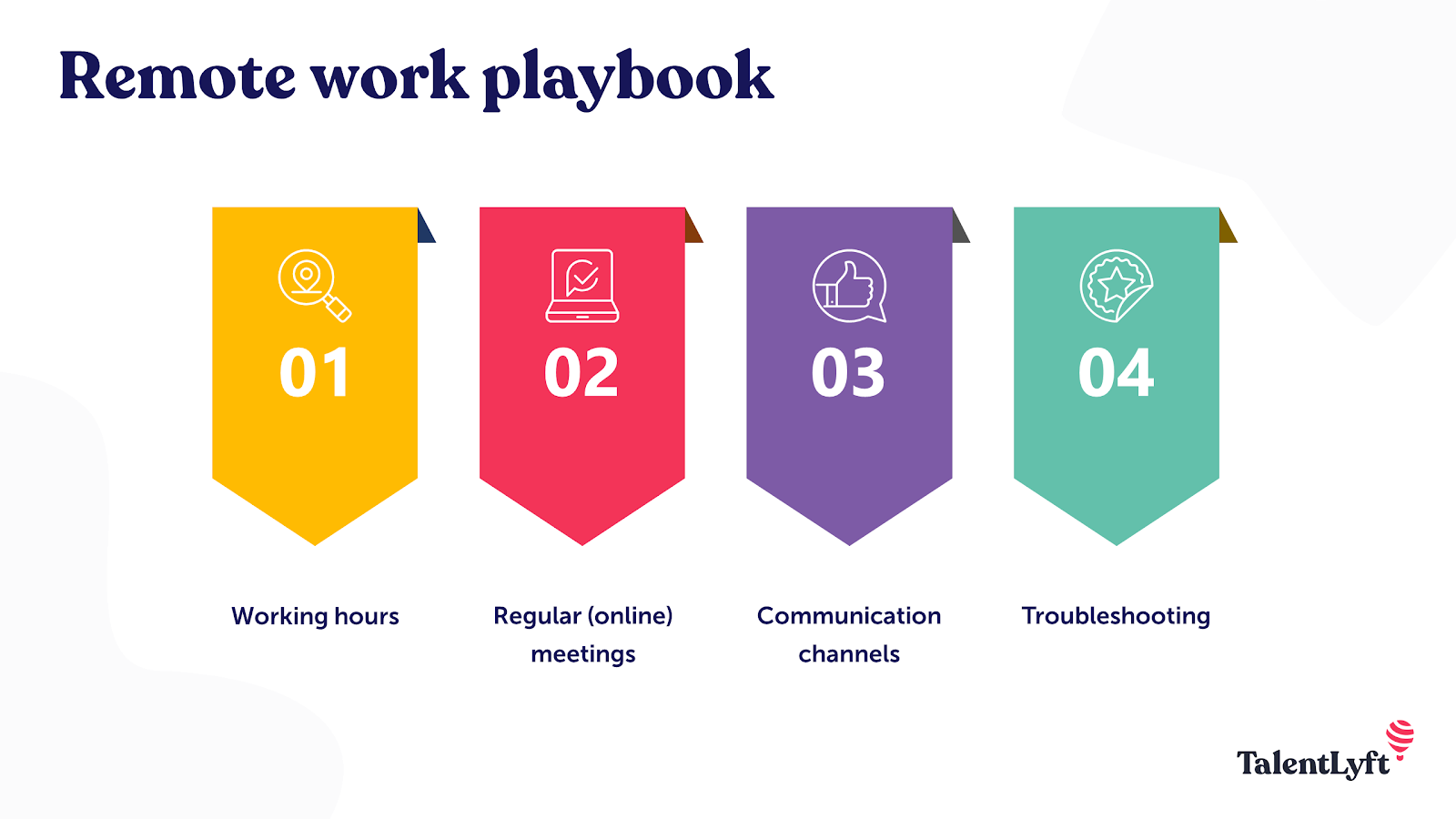
➡️ Remote work playbook should provide clear guidelines for:
Working hours
Do you have strict working hours or do you allow your employees to work whenever they want? At what time of the day should your employees be available online and through which channels?
Regular (online) meetings
Do you have some regular daily, weekly, or monthly meetings your employees should attend?
Communication channels
What communication channels and tools do you use? Do you use different communication channels and tools for different purposes?
Troubleshooting
Who can your employees turn to for help if they have any difficulties and challenges related to remote work?
💡 Additional useful ideas and examples
Learn from the best! GitLab is the world's largest all-remote company with over 1,300 team members located in more than 65 countries around the world. Check out their “Guide to all-remote”! Zapier is a 100% distributed company with over 300 remote employees in 17 time zones and 28 countries. Check out their “The ultimate guide to remote work”!
Regular check-ins with your employees are a must when you’re working remotely. Regular check-ins will ensure that your remote teams are on the same page regarding their work duties. However, these meetings have additional value - they will create a sense of togetherness. 🤗
The best practice is to have daily team or department check-ins, weekly coordination meetings, and monthly all-hands meetings. Make sure your team leaders also keep their regular one-on-one meetings.
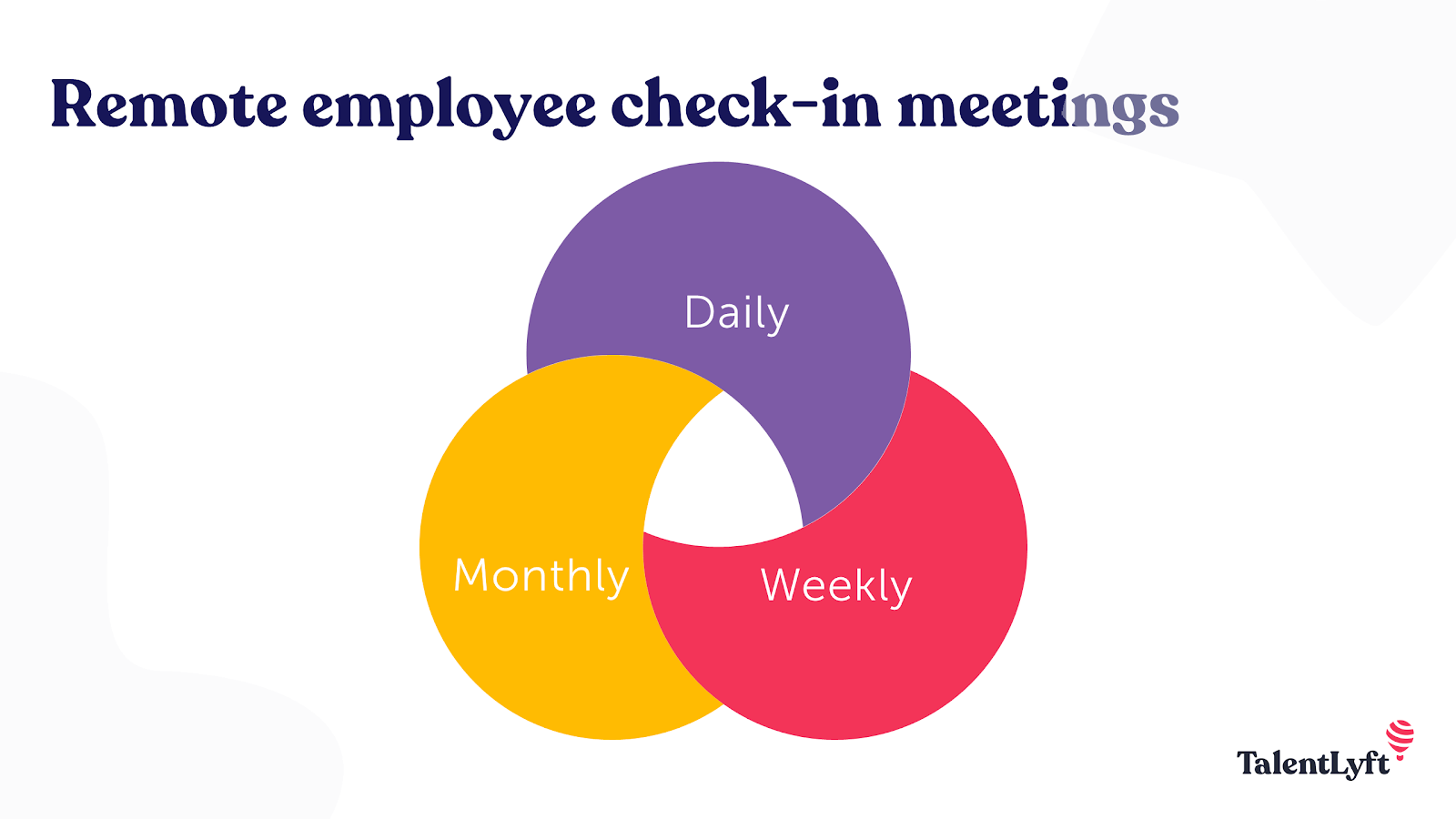
You can choose to have these meetings via messenger, chat, or speaking face-to-face on a video call - whatever works best for your team.
➡️ However, make sure that you have at least some of your check-in meetings via video conferencing tools, with your cameras ON. Nothing can replace the human connection that is formed by looking someone in the eye - even if it is only via video conferencing!
💡 Additional useful ideas and examples
Learn the best tips for short, but efficient check-in meetings!
At the office, coffee breaks tend to be spontaneous - people simply swing by their colleague’s desk and invite them for a quick coffee break. Taking short breaks from work to meet up with colleagues has been proven to be effective in boosting employee engagement and productivity.
This is why you should think about implementing “virtual coffee breaks” when your employees are working remotely. “Virtual coffee breaks” are simply short (usually 15 to 30 minutes long) video calls during which your employees come together for a round of small talk over a cup of coffee. ☕
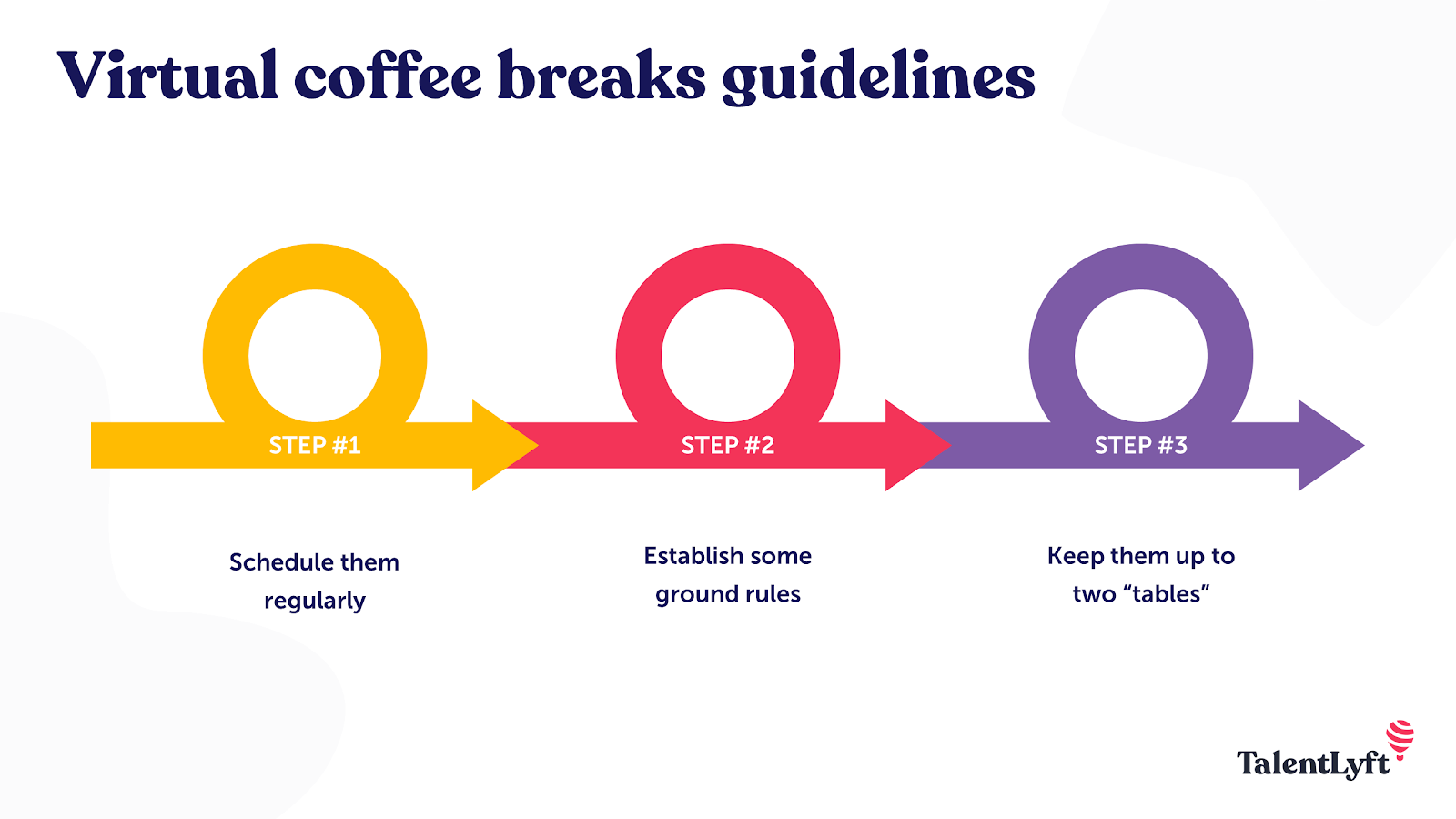
➡️ Here are some tips to make your “virtual coffee breaks” a success:
Schedule them regularly at predictable times
Whether you decide to have your company’s “virtual coffee break” once per day or a week, make it predictable. This will make it stick easier.
Establish some ground rules
Are your “virtual coffee breaks” completely casual and optional? Or do you have some rules (such as no phones or checking messages, being on time, etc.)?
Keep it up to one to two “tables” max
If you have larger teams, break your “virtual coffee breaks” into smaller groups so that each person can be heard.
💡 Additional useful ideas and examples
Check out 25 fun ideas for your next “Virtual coffee break”!
Chances are your employees will have to attend a lot of video calls and meetings while working remotely. That’s understandable because face-to-face communication is the fastest and easiest way to get all your remote team members on the same page. 📹
However, if you want to keep your employees engaged during your video meetings, make sure not to schedule them too often. Video meetings should be reserved for discussion and urgent issues and they should only involve people who have something to contribute to them.

➡️ Each of your video meetings has to have a clear purpose and well-defined agenda that is shared in advance before the meeting starts, so everyone can come prepared. It is also a good idea to have a dedicated timekeeper and facilitator. Make sure you rotate these roles and give each of your team members a chance to run a meeting, as this will help keep them engaged.
💡 Additional useful ideas and examples
If you want to spice up your video meetings and make them fun, try with the pet, hat or similar theme. Invite your video meeting attendees to wear a funny hat or show off their pets.
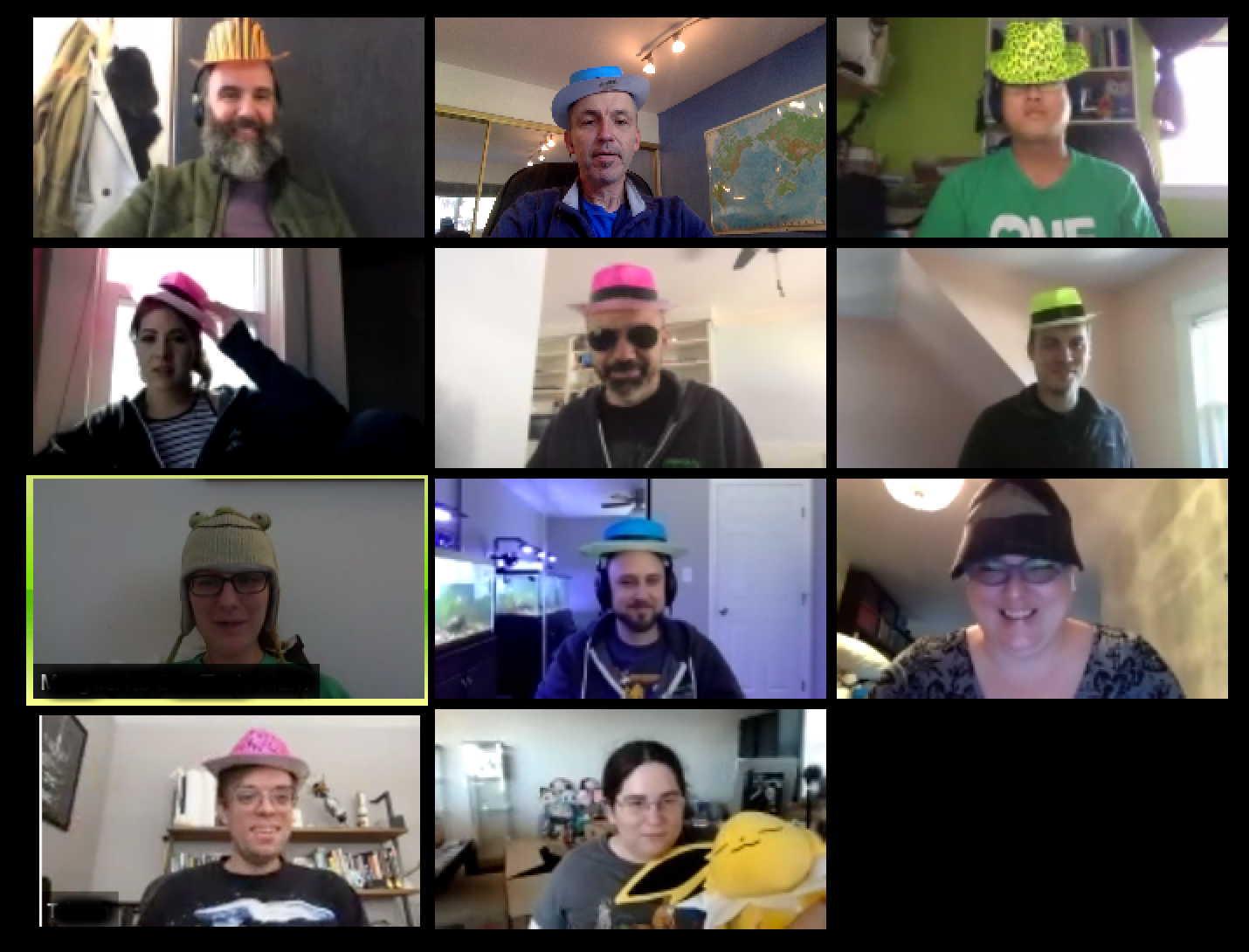
Another thing that’s missing from the virtual office space is the chance for your employees to meet their colleagues by the water coolers and engage in some small talk. “Water cooler talk” is the term used to describe casual discussions between co-workers about non-work-related topics. 🚰
Personal interactions are an essential part of each company's culture because they make work meaningful and enjoyable. These casual talks provide opportunities for your team members to come to get to know each other better. This is why you should introduce virtual water cooler space!
➡️How to do it? Create a dedicated virtual water cooler space on Slack or any other messaging chat you use. You can name it simply #watercoolerchat or simply #life. Encourage your employees to share updates, sites, news, and fun, non-work-related things.
💡 Additional useful ideas and examples
To further engage your employees in this water cooler chat, introduce a daily question, theme, or topic. Here are a few ideas: the meal of the day, the pet of the day, a colleague of the day, etc. Invite your team members to respond with a photo, video, or a funny GIF!
While you should always consider organizing onsite team buildings if possible, don’t underestimate the power of online team buildings. Online versions of team buildings can be just as effective! Some people even prefer them because they are more convenient and provide the same sense of togetherness, fun, and enjoyment. 🥳
There are many different online activities and games you can use to help your remote employees get to know one another and build stronger connections. What type of team building you should organize should be directed by your company culture and your employees' wishes. Consider suggesting a few options and asking your remote employees to choose the one they prefer.
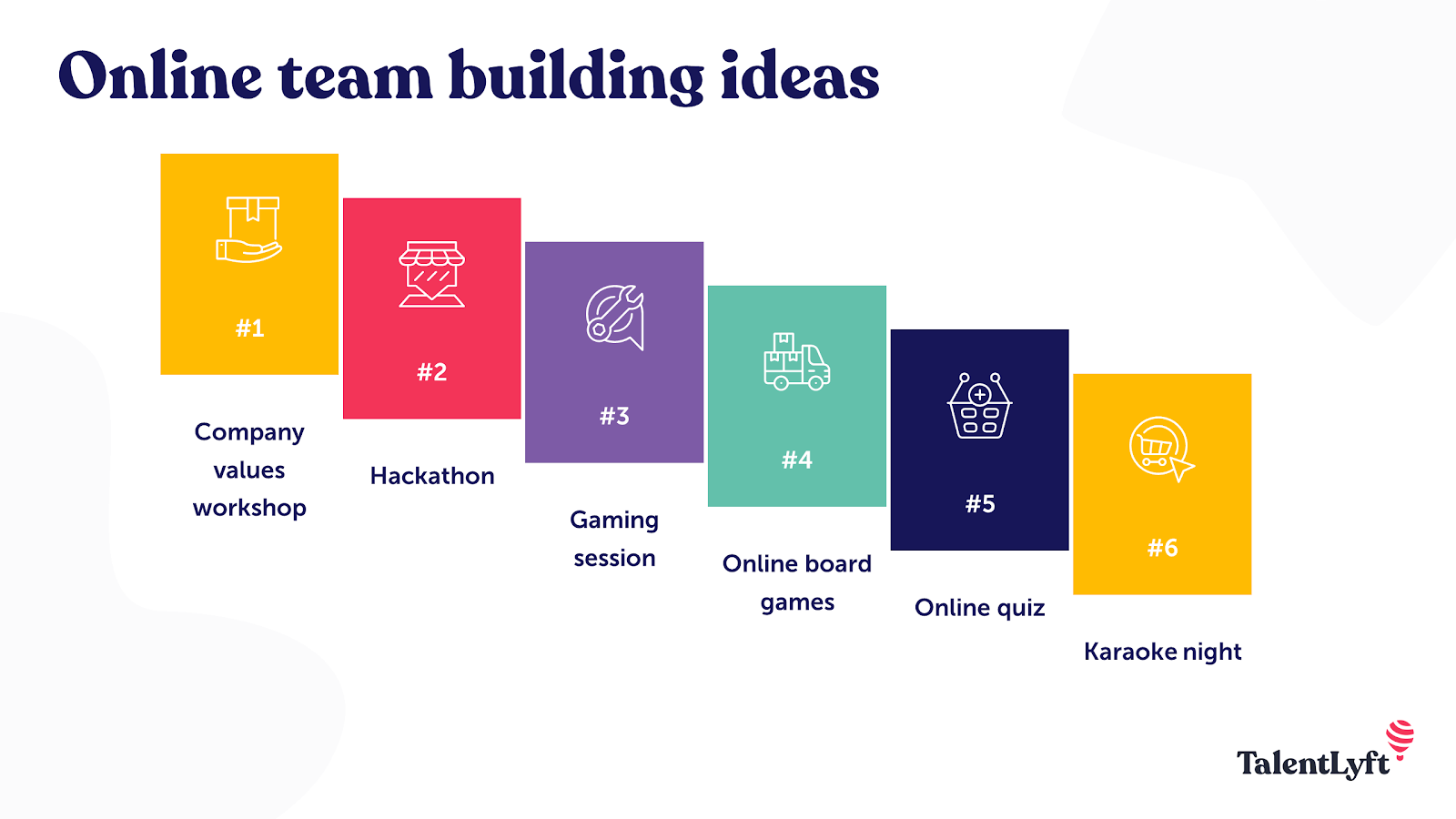
➡️Here are just a few ideas to get your creative juices flowing:
Company culture workshop
Hackathon
Online board games
Quiz
Gaming session
Karaoke or movie night.
💡 Additional useful ideas and examples
If you’re looking for more ideas, check out these 52 creative virtual team-building activities!
According to scientific research, knowledge sharing significantly and positively affects employee engagement. Knowledge sharing among employees enables them to grow at both personal and group levels, thus driving productivity and innovation. 🤓
Knowledge sharing in the workplace is the process of sharing expertise, information, and skills among employees in a company. This process happens relatively spontaneously when employees are working side by side, but when employees are working remotely, you need to put in some effort to structure it.
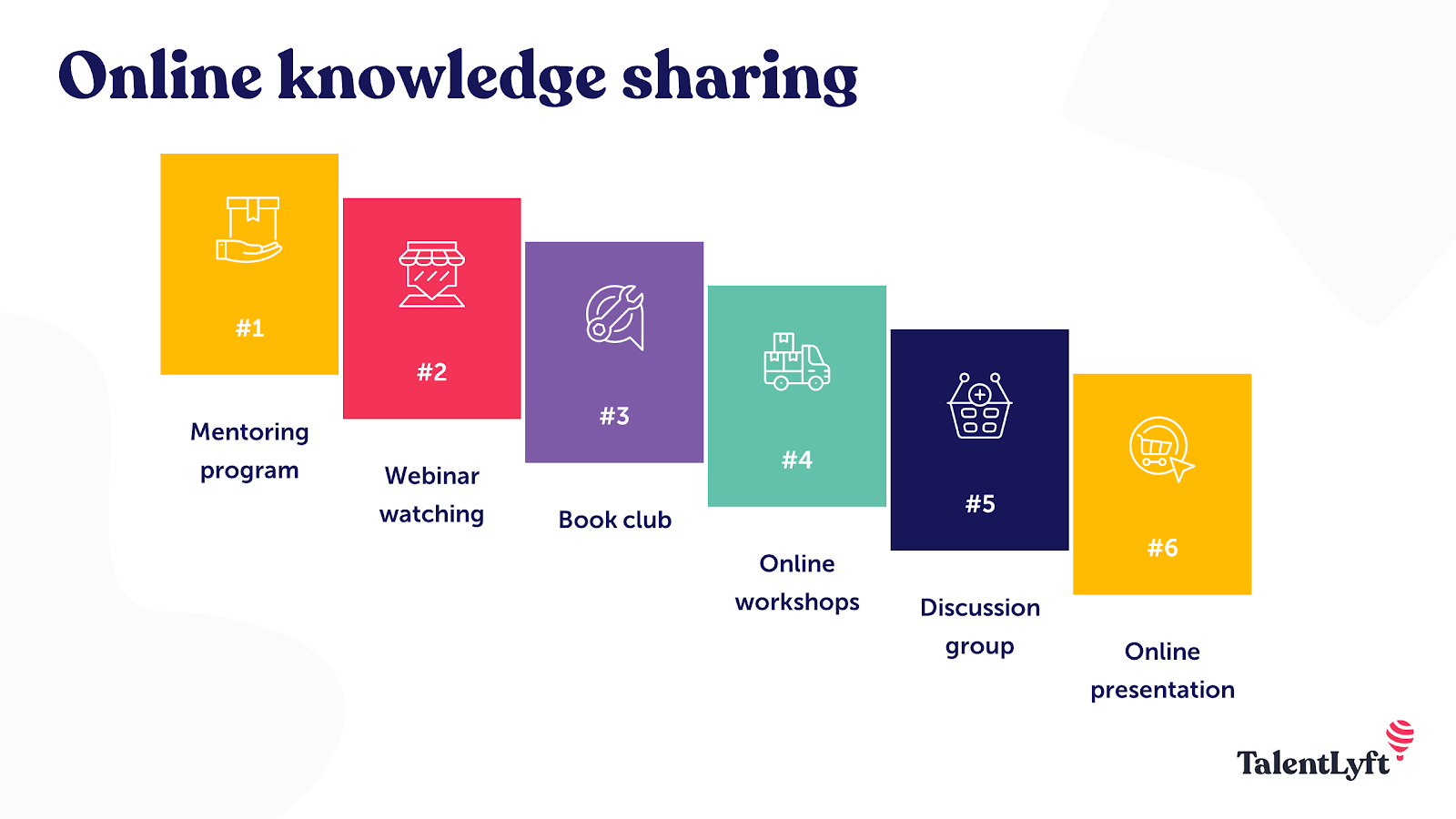
➡️ Here are a few good practices that will help you start online knowledge-sharing sessions:
Mentoring program
Webinar watching
Book club
Problem-solving workshops
Discussion Group
Monthly presentation or a talk.
💡 Additional useful ideas and examples
Check out some more knowledge-sharing best practices!
According to Gallup research, recognition not only boosts individual employee engagement but it also has been found to increase productivity and loyalty to the company, leading to higher retention. Gallup's data reveal that the most effective recognition is honest, authentic, and individualized to each employee.
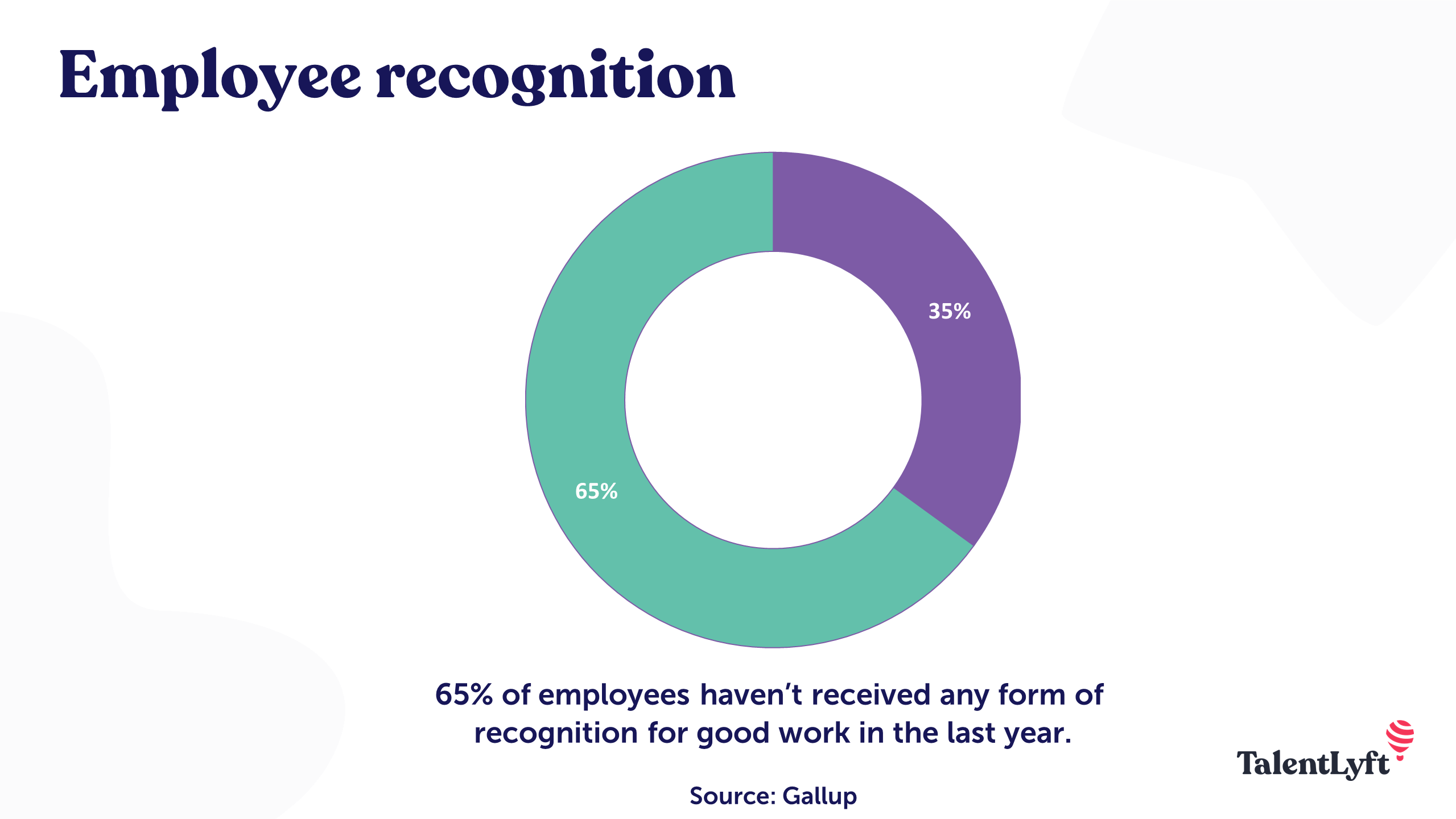
This is why you must institute an online recognition system for your remote employees. There are many different ways to do it, but I suggest you start with something very simple and free.
➡️ Create a kudos channel on Slack or any other messaging chat you use. Lead by example and start using it to celebrate wins and recognize good work. This online recognition ritual is well accepted by introverts as well, according to Red Shift’s experience.
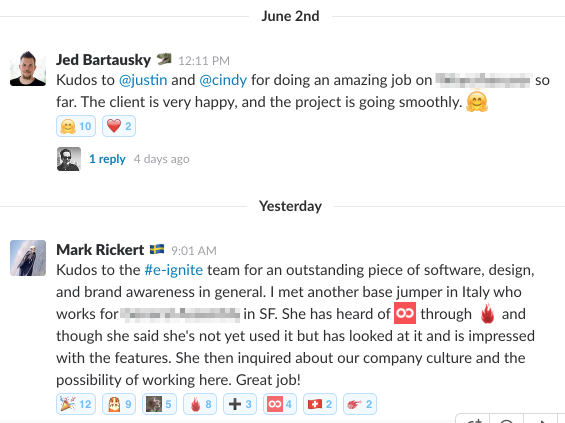
💡 Additional useful ideas and examples
Discover an additional 20 ideas for employee recognition programs!
When we work on-site, leaving the office symbolizes the end of the workday and workweek. However, when you are working and chilling at the same place, it isn't so easy to maintain boundaries between working and resting.
Thus it comes as no surprise that a comprehensive State of Remote Work 2020 research conducted by Buffer has found that the third biggest challenge of remote employees is unplugging from work.
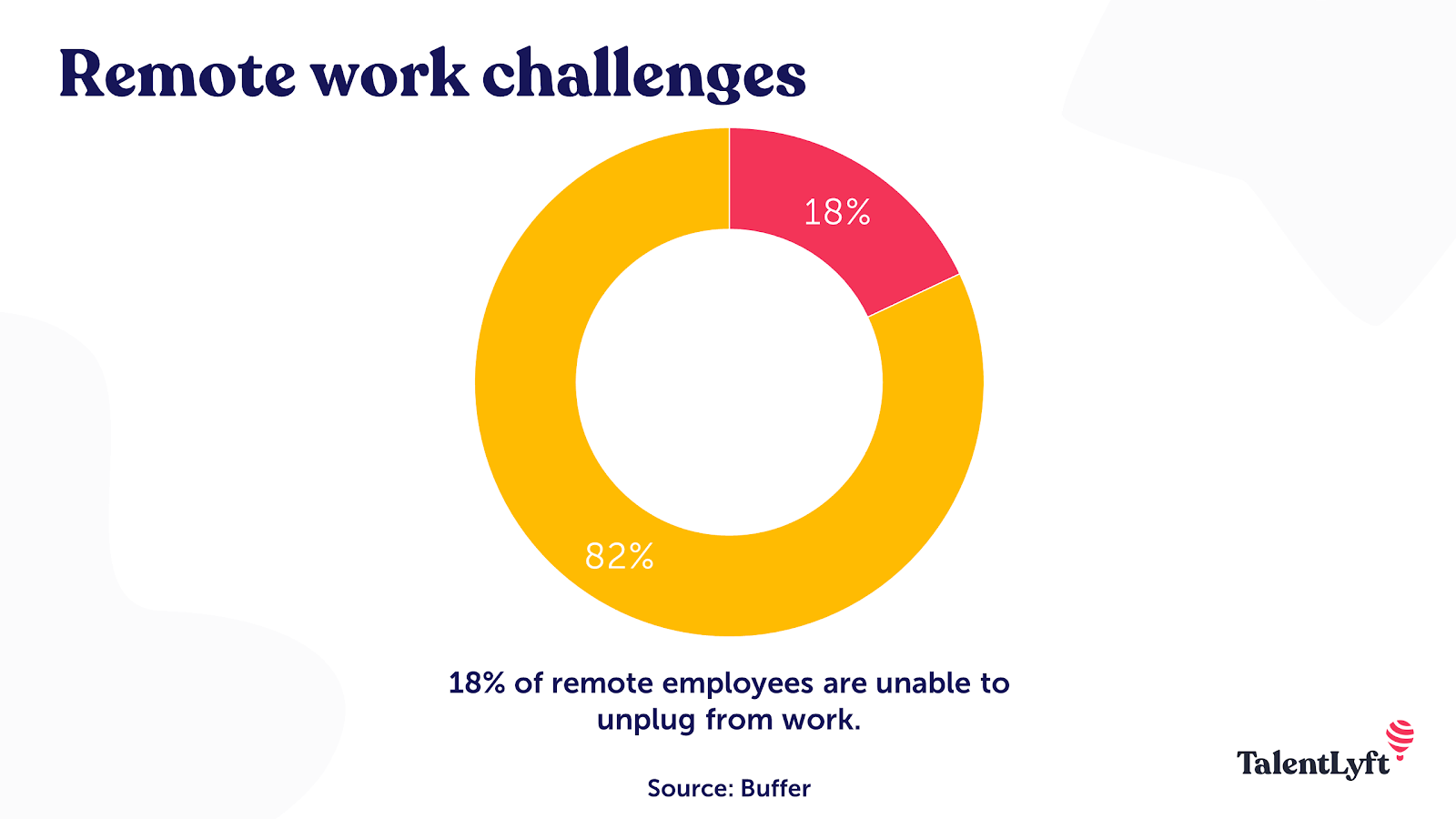
This is a very serious problem because staying plugged in means your employees aren’t able to rest, which will eventually lead to burnout. To prevent it, I suggest instituting company-wide so-called Friday close-off meetings.
➡️ At the end of the workday each Friday, gather your team for a short, half-hour video meeting. Use it to acknowledge the work you have done during the week, celebrate your wins, and share plans for the weekend.
💡 Additional useful ideas and examples
Check out our practical Guide for HR Professionals: How to avoid burnout and retain your employees?
Building and maintaining strong employee engagement can be challenging when you have remote employees - especially if they’re not used to remote work. Your remote employees might be facing different challenges, but you won’t know about them unless you ask.
It is not likely your remote employees will feel your daily stand-up meetings are an appropriate place to address their concerns. Since face to face time is relatively rare and valuable in the remote working setting, you won’t have the opportunity to see if your remote employees are dealing with some work-related issues. 🧐
This is why you should conduct periodic engagement surveys regularly! Try sending out these surveys at least once a month. That way, you’ll be able to compare results and see if there are any changes or issues that need to be tackled.
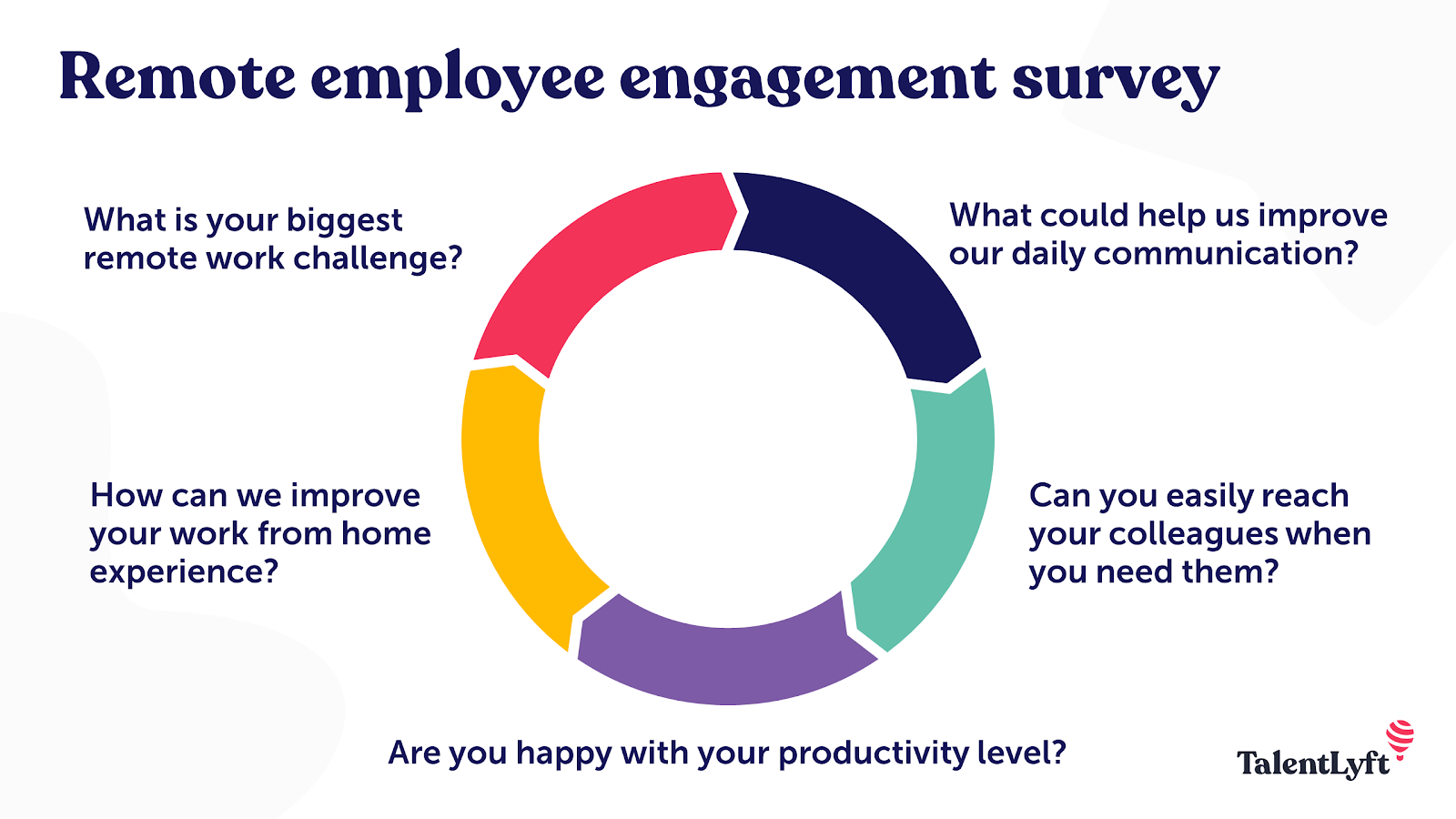
➡️ Here a few engagement questions for remote employees you should definitely include in your survey:
What do you think could help us to improve daily communication?
Do you feel like you can easily reach your colleagues when you need them?
How can we help you improve your work from home experience?
Are you happy with your productivity level?
What is the biggest challenge you are currently facing while working remotely?
The most important part of conducting employee engagement surveys is to act on them! Check in with your remote employee who is experiencing challenges and make a plan to successfully tackle those challenging issues.
💡 Additional useful ideas and examples
To help you get started, we created a sample of great employee engagement survey questions!
I designed the above remote employee engagement ideas with a clear intention. My intention was not just to introduce cool ideas your employees might like and enjoy. While fun and enjoyment are a cherry on the top, each of these ideas is carefully selected to address a specific issue. 🎯
To successfully engage your remote employees, you need to understand them. You need to dive deep and learn about their struggles. Do you know what are the top 3 challenges for employees who are working from home? 🤔
According to Buffer’s State of Remote Work 2019, the biggest struggles related to remote work are:
Communication
Loneliness
Unplugging from work.
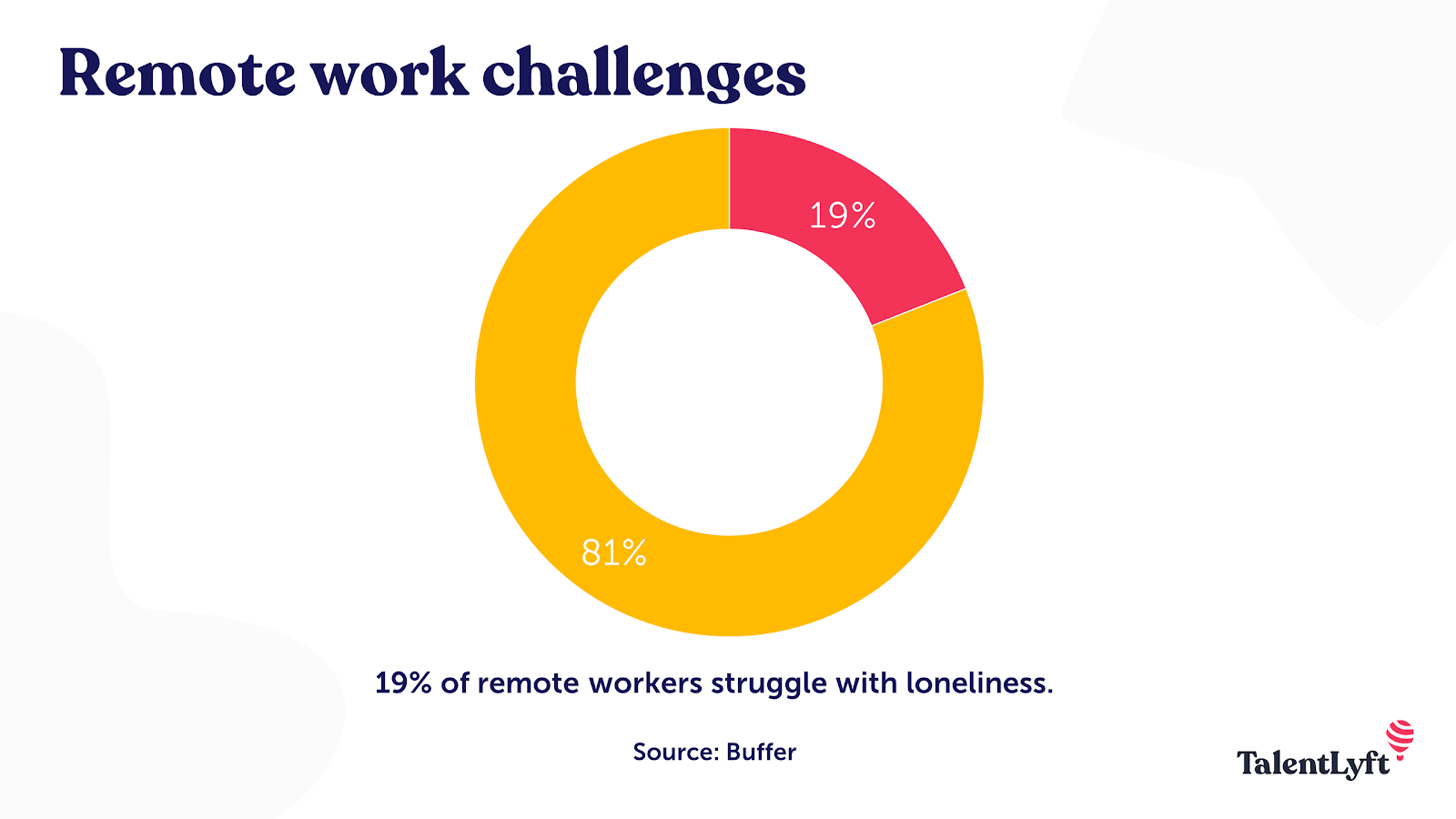
Buffer found that 19% of remote workers report loneliness as their top work struggle. This is extremely important because remote employees who feel lonely and isolated can experience performance declines of up to 21%, according to Gallup research. 😲
Even if your remote employees are not lonely, they are probably longing for connection. According to a study by Slack, 85% of workers want to feel closer to their remote colleagues.
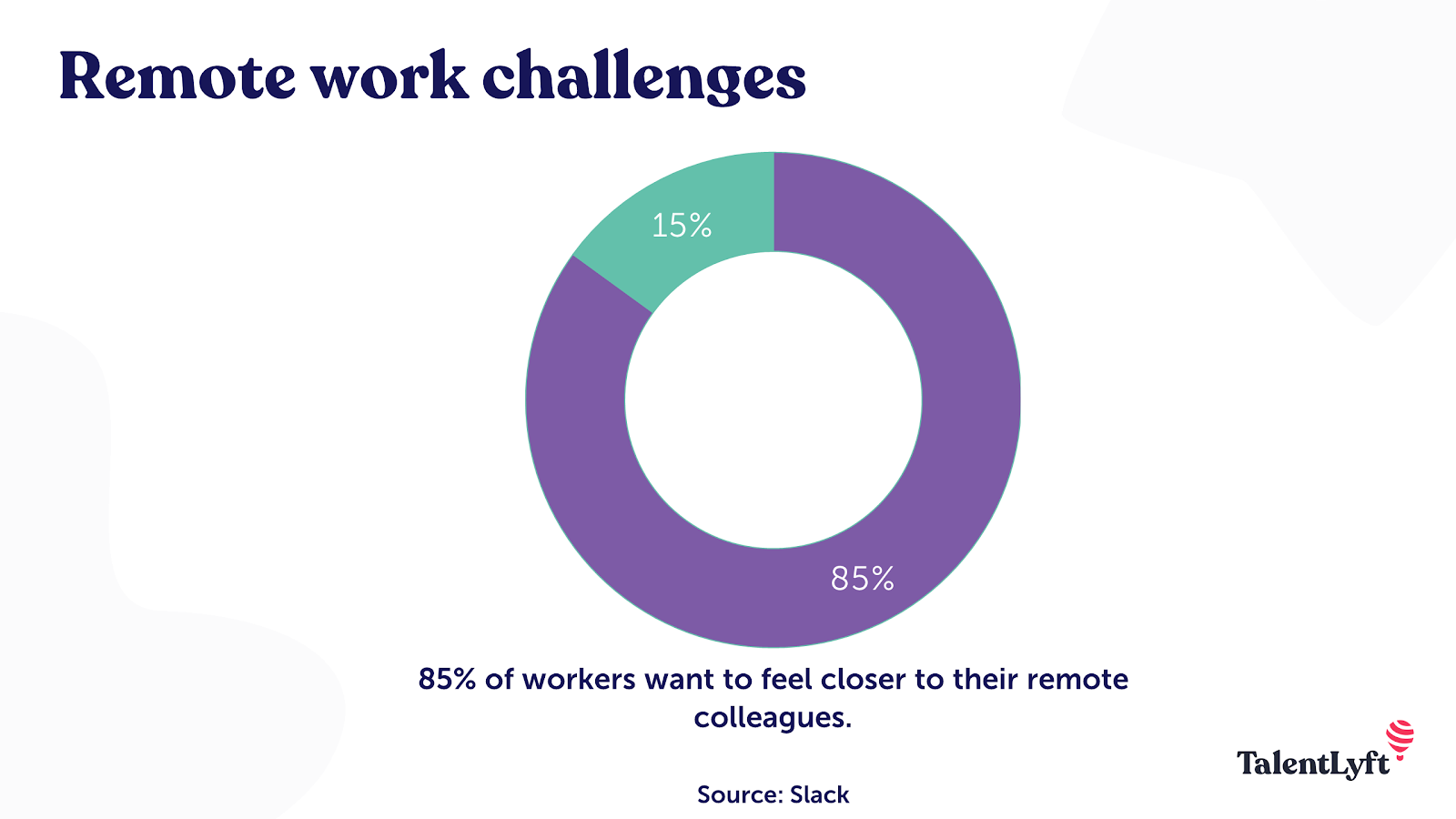
💡 Implementing these ideas will help you improve communication with your remote employees, create opportunities for them to connect as a team and finally, help your employees unplug from work, so they recharge and come back bursting with energy and excitement to start another week.
If you’re reading this blog post, you probably know just how important it is to have motivated and engaged employees. But just in case you need some help introducing one of these ideas to your C-suite and your team leaders, I’ve prepared a few handy stats to help you out. 😉
But before we jump into statistics that prove just how important employee engagement is, you first need to explain what employee engagement is. 👇
Kevin Kruse, the author of an interesting book “Employee engagement for Everyone”, defines employee engagement as “the emotional commitment the employee has to the organization and its goals”.
Why is it important that your employees are emotionally invested in their job and the company? 🔍
Simon Sinek, the author of a great book “Start With Why,” describes in a simple way why employee engagement is so important: “When people are financially invested, they want a return. When people are emotionally invested, they want to contribute.” ❤️

In other words, engaged employees are those who are not working just to collect their paycheck at the end of the month. Instead, they show up at work every day excited and ready to go the extra mile. 💪
📊 Now that you have your storytelling in place, it’s time to back it up with the numbers:
Only 15% of employees are engaged in the workplace, according to Gallup’s State of the Global Workplace research.
Disengaged employees are 12 times more likely to leave their jobs over one year than highly engaged employees, as found by Glint's study.
Engaged employees are 21% more productive, according to Gallup research.
Companies with engaged employees report 22% higher profitability, according to Gallup.
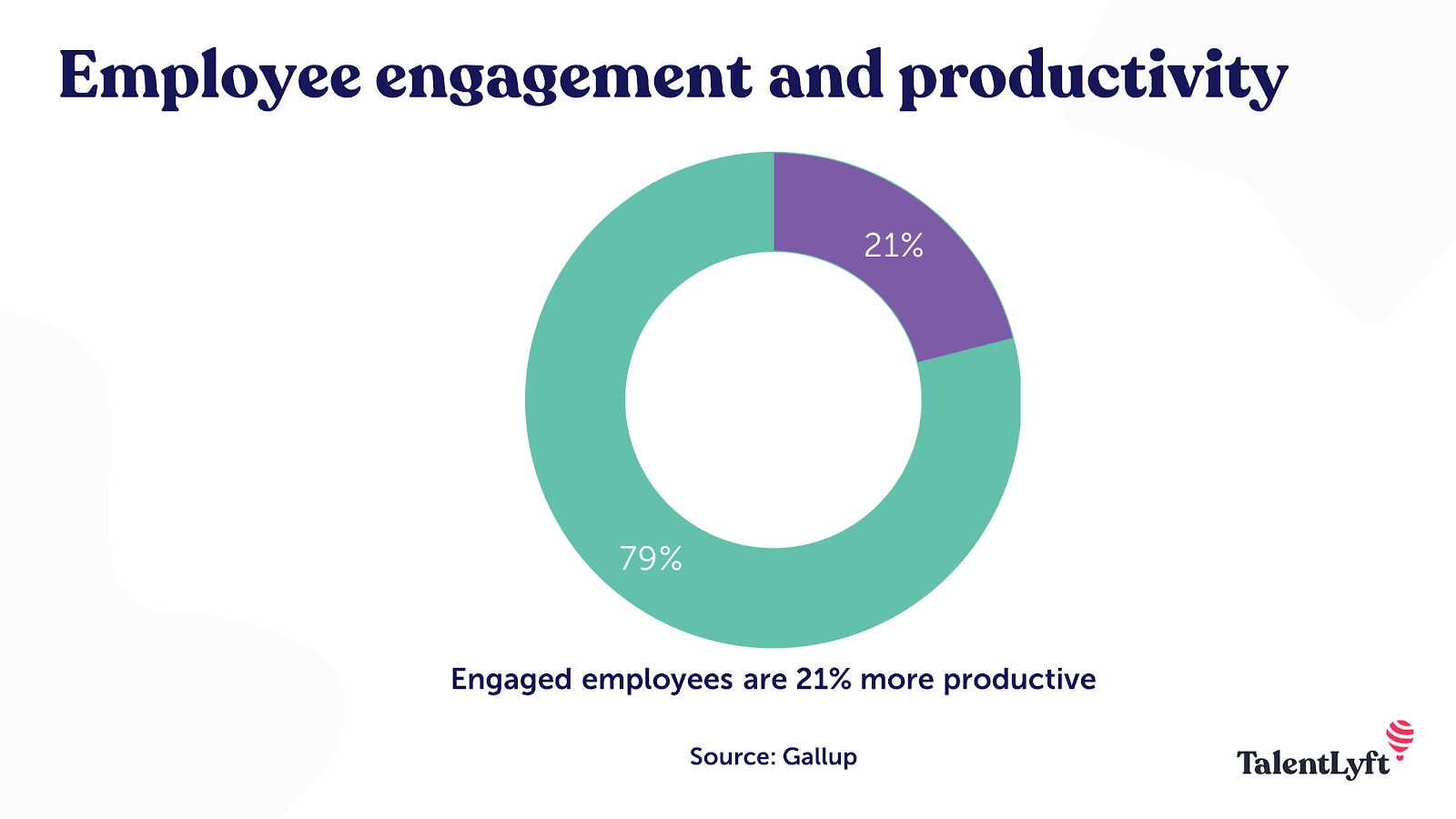
A meta-analysis confirmed that there is a well-established connection between employee engagement and profitability, productivity, turnover and absenteeism.
Pretty convincing, huh? 😉
How can I keep remote employees engaged while working from home?
Discover creative and effective ways to maintain high engagement levels among your remote workforce, including virtual team-building activities and regular check-ins.
What are some unique work-from-home team-building activities?
Find out about innovative team-building exercises tailored for remote employees to foster a sense of community and collaboration.
Why is employee engagement important in a remote work setting?
Understand the significance of keeping employees engaged in a work-from-home environment for productivity, morale, and overall job satisfaction.
Can virtual coffee breaks enhance remote employee engagement?
Learn how implementing casual virtual meetups like coffee breaks can promote connectivity and a sense of belonging among remote teams.
What tools can help in engaging employees working from home?
Explore various digital tools and platforms that facilitate effective communication, collaboration, and engagement in a remote work setting.












